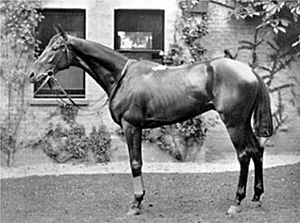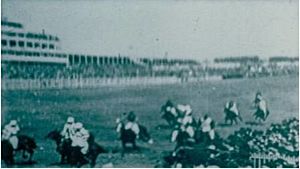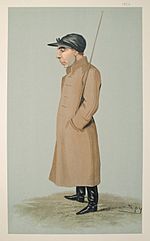Sir Visto facts for kids
Quick facts for kids Sir Visto |
|
|---|---|

Sir Visto as photographed by Clarence Hailey.
|
|
| Sire | Barcaldine |
| Grandsire | Solon |
| Dam | Vista |
| Damsire | Macaroni |
| Sex | Stallion |
| Foaled | 1892 |
| Country | United Kingdom of Great Britain and Ireland |
| Colour | Bay |
| Breeder | Lord Rosebery |
| Owner | Lord Rosebery |
| Trainer | Mathew Dawson |
| Record | 13: 3-1-3 |
| Earnings | £14,334 win prize money |
| Major wins | |
| Epsom Derby (1895) St Leger (1895) |
|
Sir Visto (born 1892, died 1914) was a famous British Thoroughbred racehorse. A Thoroughbred is a special type of horse bred for racing. Sir Visto was also a sire, meaning he was a male horse used for breeding other racehorses. During his racing years from 1894 to 1896, he competed thirteen times and won three races. His biggest wins came in 1895 when he won two very important races: The Derby and the St Leger. After 1895, he didn't win any more races and retired in 1896 to become a breeding horse.
Contents
About Sir Visto
Sir Visto was a bay horse, which means he had a reddish-brown body with a black mane, tail, and lower legs. People described him as long and powerful, even though he looked a bit "unfinished." He was bred by his owner, Lord Rosebery, at the Crafton Stud. Lord Rosebery was a very important person in Britain. He was a leading politician and even became the Prime Minister in 1894.
Sir Visto's trainer was Mathew Dawson, a very experienced horse trainer. The St Leger win was the last of 28 "classic" race wins for Dawson. Classic races are the most important and famous races for young horses. Even though Dawson had mostly retired, he still trained a few horses, including Sir Visto.
Sir Visto's father was an amazing Irish champion horse named Barcaldine, who never lost a race. Sir Visto's mother, Vista, was also a great horse for breeding. She produced other successful racehorses, including Velasquez, who came second in the Derby, and Bona Vista, who won another big race called the 2000 Guineas.
Sir Visto's Racing Life
1894: Two-Year-Old Races
Sir Visto's first race was at Epsom in June. He wasn't expected to win and finished without placing in the Woodcote Stakes. People later said he wasn't fully ready for that race.
He then took a break for four months. His next race was the Imperial Produce Stakes at Kempton. He led the race in the final part and won by a very small distance, called a "short head."
By the end of the year, people noticed Sir Visto was growing well. He was even seen training with another famous horse, Ladas, who had won the Derby in 1894.
1895: Three-Year-Old Races
Spring Races
Before the 1895 racing season started, Sir Visto was seen as one of the top horses for the Derby. Many thought it would be a very close race that year. Lord Rosebery believed Sir Visto was a "stayer," meaning he could run long distances well, which was good for the Derby's mile and a half length.
Sir Visto's first race as a three-year-old was the 2000 Guineas at Newmarket on May 1st. He was the third favorite to win. He ran well and was in the lead halfway through the race. But in the last part, he was overtaken and finished third.
Two weeks later, he raced again in the Newmarket Stakes. It was a very exciting race, and Sir Visto finished third again, losing by only a small distance.
Summer Races: Winning the Derby
On May 29th, Sir Visto competed in the Derby at Epsom. He was one of the favorites, with odds of 9 to 1. The race happened on a sunny day with a big crowd, including the Prince of Wales.
Sir Visto, ridden by Sam Loates, started at the back of the group. He slowly and quietly moved forward in the last half mile. Two other horses, Curzon and Kirkconnel, were battling for the lead. But then, Sir Visto suddenly appeared, moving very fast, and took the lead just 50 yards from the finish line! He won by three-quarters of a length.
This Derby race was special because it was one of the first horse races ever filmed. The film was thought to be lost for a long time but was found again in 1995.
After his big Derby win, Sir Visto raced in the Princess of Wales's Stakes on July 4th. He carried a lot of extra weight in this race (131 pounds), which makes it harder for a horse to run fast. He didn't finish among the leaders.
Autumn Races: Winning the St Leger
On September 11th, Sir Visto was the favorite to win the St Leger. The day before the race, he had a small accident in his stable and hurt his front leg a little. But he was still allowed to race.
Just like in the Derby, Sir Visto started near the back. A horse named Butterfly took the lead in the final part of the race. But Sam Loates moved Sir Visto up to second place. With one furlong (about 200 meters) left, Sir Visto took the lead and held on to win by three-quarters of a length. It was a very exciting race!
After the St Leger, Sir Visto looked tired and sore. People thought it was because of the hard race and his leg injury. Sir Visto never won another race after this.
His last race of the year was the Jockey Club Stakes on September 26th. He carried a lot of weight (133 pounds) and didn't finish well.
1896: Four-Year-Old Races
Sir Visto continued training as a four-year-old. His main goal was the Gold Cup race. He looked very impressive, having grown into a "grand horse." However, he finished last in the Gold Cup on June 18th.
He did a bit better in his next race, the Princess of Wales's Stakes, finishing fifth against some very strong horses like St Frusquin and Persimmon.
On October 2nd, he had his best race in a long time. He finished second to Persimmon in the Jockey Club Stakes. He carried the most weight (142 pounds) but still beat many other good horses.
Eleven days later, he was the favorite to win the Champion Stakes, but he finished third. His very last race was the Cambridgeshire Handicap on October 28th. He carried 122 pounds and finished twelfth out of twenty-four horses. After this, he retired from racing.
Sir Visto's Achievements
After winning the Derby, his trainer Mathew Dawson thought Sir Visto was a very good horse. Later, after he won the St Leger, many people said he was the best "stayer" (long-distance runner) of his time.
Sir Visto earned a lot of money from his wins: £4,309 when he was two years old and £10,025 when he was three.
Life After Racing
Sir Visto retired to the place where he was born, Mentmore, to become a breeding horse. However, he didn't produce many famous racehorses. His last foals (baby horses) were born in 1908. After that, he retired completely to Lord Rosebery's stables near Epsom.
Sir Visto was put to sleep in July 1914 because of old age or illness. He was buried at The Durdans, and there is still a stone marking his burial spot.
Images for kids






